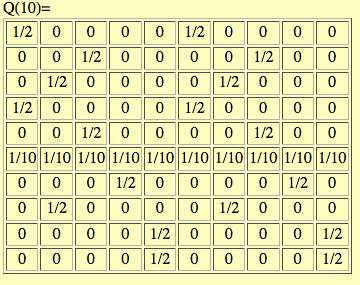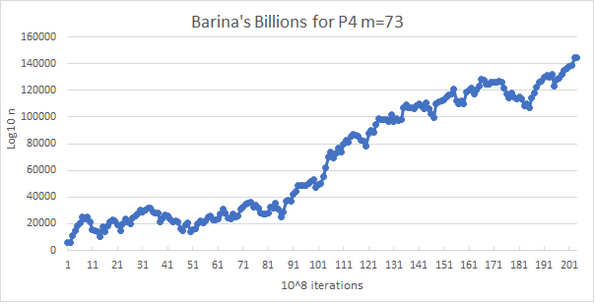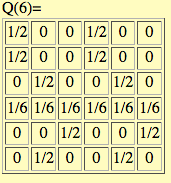
If n is even, T(n) = n/2; if n is odd and divisible by 5, then T(n) = (m*n/5 + 1)/2, otherwise T(n) = (3n + 1)/2, for some fixed odd integer m ≥ 3.
This is very similar to the 3x+1 mapping unless n is odd and divisible by 5, and if we set the parameter m = 15, it is exactly the 3x+1 mapping.
He conjectured that the iterative sequence x, T(x), T(T(x)),... is always bound to converge to one of a finite number of finite cycles for all m ≤ 73 (later changed to m < 73).
Mapping P4 can be regarded as a d-branched generalized 3x+1 mapping T: ℤ → ℤ,
where T(x) = int(mix/d) + Xi, if x ≡ i (mod d), where d = 10,
m0 = 5, m1 = 15, m2 = 5, m3 = 15, m4 = 5, m5 = m, m6 = 5, m7 = 15, m8 = 5, m9 = 15 and
X0 = 0, X1 = 1, X2 = 0, X3 = 1, X4 = 0, X5 = 1, X6 = 0, X7 = 1, X8 = 0, X9 = 1:
\[ T(x)=\left\{ \begin{array}{cc} x/2 & \mbox{ if $x\equiv 0\pmod{10}$}\\ (3x+1)/2 & \mbox{ if $x\equiv 1\pmod{10}$}\\ x/2 & \mbox{ if $x\equiv 2\pmod{10}$}\\ (3x+1)/2 & \mbox{ if $x\equiv 3\pmod{10}$}\\ x/2 & \mbox{ if $x\equiv 4\pmod{10}$}\\ (mx+5)/2 & \mbox{ if $x\equiv 5\pmod{10}$}\\ x/2 & \mbox{ if $x\equiv 6\pmod{10}$}\\ (3x+1)/2 & \mbox{ if $x\equiv 7\pmod{10}$}\\ x/2 & \mbox{ if $x\equiv 8\pmod{10}$}\\ (3x+1)/2 & \mbox{ if $x\equiv 9\pmod{10}$} \end{array} \right. \] This mapping is of type (b) where type (b) means gcd(mi, d2) = gcd(mi, d) for 0 ≤ i ≤ d - 1.
Then conjecturally, we get everywhere cycling if and only if the weighted product P = Π0 ≤ i ≤ d-1(mi/d)pi < 1, where (p0, ..., pd-1) is the stationary vector of the Markov matrix Q(d), which is defined in that paper.
It seems certain that the 10×10 Markov matrix Q(10) is independent of m, but I haven't the patience to prove this.
We calculate Q(10) for m = 73, using the BCMath program Generalized 3x+1 functions and Markov matrices.

P = (1/2)10 (3/2)14 (1/2)13 (3/2)8 (1/2)10 (m/10)10 (1/2)14 (3/2)13 (1/2)8 (3/2)10 < 1
if and only if m < 5(211)/3(9/2) = 72.988...,
So we expect everywhere cycling if and only if m < 73.
The case m = 73 is interesting. We expect to find trajectories n0, T(n0), T(T(n0)),...that appear to be divergent. One such example is n0 = 100545. David Bařina has followed this trajectory for 20,400,000,000 iterations reaching an iterate of 144,284 digits.
Conjecturally, (Tk(n0))1/k → P = 1.0000143...
 (graph supplied by Brian Gurbaxani)
(graph supplied by Brian Gurbaxani)
My CALC cycle program finds 18 cycles with starting points (and lengths):
0 (1), -1 (1), 1 (2), 5 (11), -5 (9), -17 (6), 71 (58), -1265 (5470), -1237 (43), -4337 (21), -3257 (21), -4129 (21), 505 (807), -1375 (21), -1055 (21), -1385 (21), -4313 (21), -4157 (1923).
T(x) = int(mix/6)+Xi, if x ≡ i (mod 6), i = 0,...,5, and where
m0 = 3, m1 = 15, m2 = 3, m3 = 7, m4 = 3, m5 = 15,
X0 = 0, X1 = 1, X2 = 0, X3 = 1, X4 = 0, X5 = 1.
The Markov matrix approach can be used, as gcd(mi, d2) = gcd(mi, d) for all i, with d = 6.
We calculate the Markov matrix Q(6) using the BCMath program Generalized 3x+1 functions and Markov matrices.

The weighted product is
P = (3/6)(6/26)(15/6)(4/26)(3/6)(3/26)(7/6)(6/26)(3/6)(4/26)(15/6)(3/26)
= 5776/(22636) = 0.1878... <1.
Hence we expect all trajectories to eventually cycle.
My CALC cycle program finds 13 cycles with starting points (and lengths): 0 (1), -1 (2), 1 (4), -3 (1), 21 (309), 7 (6), -63 (20), -41 (20), 141 (6), 85 (6), 121 (6), 1303 (33), 69721 (44), and I am certain that all trajectories will eventually enter one of these cycles.
T(x) = int(mix/10)+Xi, if x ≡ i (mod 10), i = 0,...,9, and where
m0 = 5, m1 = 15, m2 = 5, m3 = 15, m4 = 5, m5 = 71, m6 = 5, m7 = 15, m8 = 5, m9 = 15;
X0 = 0, X1 = 1, X2 = 0, X3 = 1, X4 = 0, X5 = 1, X6 = 0, X7 = 1, X8 = 0, X9 = 1.
We expect all trajectories to eventually cycle.
My CALC cycle program finds 28 cycles with starting points (and lengths): 0 (1), -1 (1), 1 (2), 5 (12), -17 (65), 7 (6), 155 (7), -385 (75), 283 (7), 115 (7), 185 (7), 325 (7), 163 (44), 235 (7), 265 (7), 323 (7), 403 (7), 686195 (412), -915755 (173), 247123 (651), 558763 (997), 252035 (412), 175087 (890), -7523725 (585), 1559551 (412), -1578517 (173), 589015 (412), 900175 (412), 1167131 (412).
I conjecture that all trajectories will eventually enter one of these cycles.
Note that the number of iterations is limited to 100000, so it is possible for some of the listed cycles not to be reached.
For example, the trajectory starting with x = -3546464672 takes 71172 iterations to reach the cycle beginning with -17.
Last modified 15th June 2021
Return to main page